
Andor has set a new benchmark in the Star Wars universe with a staggering budget of $645 million, officially making it the most expensive Star Wars production to date. This raises a critical question regarding the recent cancellation of The Acolyte by Lucasfilm: what were the underlying reasons for this decision? Live-action Star Wars series have traditionally boasted impressive production budgets, underscored by The Mandalorian’s hefty $120 million per season expenditure. Lucasfilm aimed to match the cinematic quality of its films in its television endeavors, thus necessitating these elevated budgetary allocations.
According to tax documents filed in the U.K., Disney’s financial outlay on Andor has reached an astonishing $645 million overall, with the second season alone costing a record-breaking $290.9 million. What is particularly noteworthy is that this figure likely underrepresents the actual expenses, as it only accounts for costs up to November 22, 2023, thereby omitting the entirety of the filming process. Comparatively, The Acolyte was budgeted at $230.1 million before its cancellation, prompting a deeper analysis of the financial decisions surrounding these two projects.
Unprecedented Financial Commitment for Andor
Andor’s Costs: Unmatched in Star Wars History

With an average budget of $26.9 million per episode over its two-season run, Andor ranks among the priciest television series ever produced. Its financial scale places it alongside major titles such as Stranger Things Season 4, The Lord of the Rings: The Rings of Power, and WandaVision. A comparative look at the budgets of other Star Wars projects elucidates just how significant Andor’s expenditure is.
| Project | Budget (inflation-adjusted) | Seasons |
|---|---|---|
| Star Wars | $74 million | |
| The Empire Strikes Back | $85 million | |
| Obi-Wan Kenobi | $90 million | 1 |
| Return of the Jedi | $104 million | |
| Ahsoka | $100 million | 1 |
| The Book of Boba Fett | $105 million | 1 |
| Star Wars: Skeleton Crew | $136 million | 1 |
| Star Wars: Episode III – Revenge of the Sith | $175 million | |
| Star Wars: Episode II – Attack of the Clones | $193 million | |
| Star Wars: Episode I – The Phantom Menace | $209 million | |
| The Acolyte | $230.1 million | 1 |
| Rogue One: A Star Wars Story | $250 million | |
| Star Wars: The Force Awakens | $314 million | |
| Solo: A Star Wars Story | $330 million | |
| Star Wars: The Rise of Skywalker | $322 million | |
| The Mandalorian | $360 million | 3 |
| Star Wars: The Last Jedi | $387 million | |
| Andor | $645 million | 2 |
Andor: Low Viewership but High Acclaim
Justifying the Investment in Andor

Faced with these impressive financial figures, one must ponder: what led Disney to endorse such a substantial budget? It is crucial to note that the budget for Andor Season 2 was approved at a time when Lucasfilm was pursuing different objectives, particularly before its current strategic pivot back to theatrical releases. This shift may complicate future large-budget television projects.
Despite initial low viewership, Andor has garnered both critical acclaim and a growing fanbase. Notably, its reputation has strengthened over time, with Jimmy Doyle, Director and Film & TV Analyst at Luminate, suggesting that the series has continued to attract viewers post-premiere. He stated, “Andor is one of the best-holding Star Wars shows, meaning people kept discovering it well after its initial release.“This favorable trajectory hints that the upcoming Season 2 could become one of the highlights of 2025.
Challenges Faced by The Acolyte
The Acolyte: A Disappointment for Fans

In stark contrast, The Acolyte faced its own set of challenges, resulting in its eventual cancellation despite a substantial $230.1 million budget. It struggled with low viewership metrics that did not improve over time, a significant factor in its early cancellation. Doyle mentioned, “The Acolyte… experienced lower viewership than most other Star Wars shows and actually lost viewership during its run.“Such a decline, coupled with unfavorable critical reception, ultimately sealed the show’s fate.
The Need for Budget Control at Disney
Sustainability in Production Budgets

While Disney may view Andor Season 2 as a smart investment, the reality is that such extravagant budgets are not sustainable in the long run. Recent indications suggest that Lucasfilm is reevaluating its approach, contemplating reductions in both the volume of upcoming shows and their associated costs.
Reflecting on the legacy of Star Wars, George Lucas maintained a level of budgetary discipline that is seemingly lacking in recent productions. Even the prequel trilogy, which featured ground-breaking CGI, remained cost-effective compared to today’s standards. Unfortunately, modern Lucasfilm’s costs have ballooned, exacerbated by various production challenges, notably for titles like Rogue One and Solo.
As Lucasfilm navigates the future of Star Wars on Disney+, it is essential to establish more manageable budgets without compromising quality. While Andor stands as a testament to what can be achieved, such expenses should be considered exceptional rather than typical. The sole upcoming live-action series, Ahsoka Season 2, is reported to involve increased location filming, raising the likelihood of higher production costs. However, it is vital for Lucasfilm to prioritize budget efficiency to ensure the franchise’s longevity.




Leave a Reply